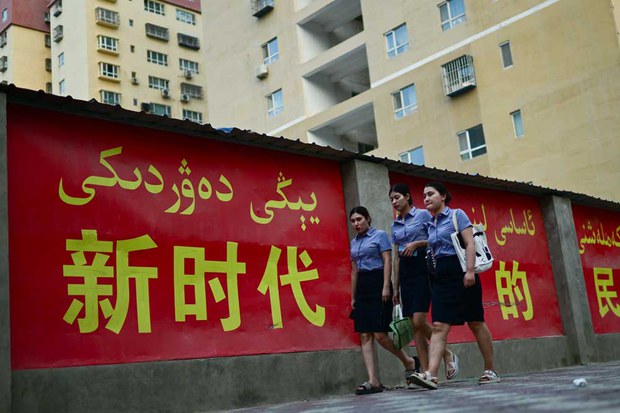In Xinjiang, questions about disappeared family members remain unanswered and reports of dubious arrests continue to emerge despite claims by the Chinese government that a widely condemned internment campaign targeting Uyghurs has ended.
The Chinese government has said the detention camps in China’s far western region were vocational training centers where the “students” voluntarily learned new skills. In 2019, the Chinese Communist Party said the attendees had graduated and most had found good jobs.
But RFA Uyghur has confirmed that detentions continue, and satellite images reviewed by the service indicate that some sites previously identified as internment facilities remain intact. Many people rounded up by police remain missing.
“Uyghurs are still very much living in a state of brokenness,” said Maya Wang, associate director of the Asia division at Human Rights Watch.

An estimated 1.8 million Uyghurs and Kazakhs have been allegedly sent to the camps. The information gathered by RFA supports recent reports by Agence France-Presse and other news outlets that Uyghurs continue to face widespread persecution, despite years of international pressure on China to ease the conditions against the group and other Muslim communities in Xinjiang.
Friends and family members have reported to RFA that their relatives are being held for crimes never fully explained by Chinese authorities.
A 45-year-old Uyghur man named Qurban Nur was held at a camp in Seriqbuya township in Kashgar for two years and two months before being released last spring, local officials told RFA.
A village security officer who acknowledged Nur’s detention told RFA that people are “continuously coming in” to the facility.

RFA has also learned of a camp still operating in the city of Korla, within the Bayingolin prefecture, northeast of Kashgar. Two men reportedly in their mid-20s – Burham Hizir and Payzulla Rahman – have been sent there since 2021, local officials said.
RFA is not identifying its sources in Xinjiang because they were not authorized to speak to the press.
International condemnation
The United States has called the crackdown campaign, which reached its peak in 2017-18, a genocide because the goal seems to be to wipe away a people’s traditions and culture through repression. The U.S. bans cotton imports from Xinjiang out of concern that Uyghurs are subjected to forced labor by authorities, in some cases after having completed their vocational training.

A 2022 report from the United Nations high commissioner for human rights found that “serious human rights violations” had been committed against Uyghurs and other Muslims in Xinjiang. Allegations of torture, forced medical treatments and rape were credible, the report found.
In its 131-page response, China said the report was based on “disinformation and lies fabricated by anti-China forces.”
China has in the past year invited journalists to visit facilities identified as detention camps that apparently had been repurposed as schools and quarantine centers.
Journalists from Sky News in the United Kingdom and the Washington Post in the United States who toured the region last year said the crackdown had eased but that mistreatment of Uyghurs and other Muslims remains a problem.

Some people caught in the mass reeducation campaign appear to have been transferred from the camps to prisons to serve out long sentences for minor offenses.
In its report, the U.N. human rights office noted that even if Chinese claims that its camp system had been dismantled are true, the “laws and policies that underpin it remain in place” and lead to increased imprisonment.
Some low-security camps appear to have been closed, but the “capacity for high security detention and higher security prisons has increased significantly,” said Adrian Zenz, a German academic whose research exposed the breadth of the campaign against Uyghurs.
It’s difficult to assess the true situation in Xinjiang given that Uyghurs are unable to freely communicate with outsiders, Zenz said.
And there’s little expectation for change. Chinese leader Xi Jinping reiterated support for the Chinese Communist Party’s policies in the region as a means to promote social stability in a speech last month in Urumqi, Xinjiang’s capital.

Abandoned homes
Agence France-Presse reporters this month visited some of the homes in Yarkant County in southern Xinjiang that Zenz’s research identified as the addresses of Uyghurs allegedly gathered up in China’s ideological reeducation effort. They found that the residences were locked or appear to have been abandoned.
Efforts to investigate further, however, were blocked by locals who ran the reporters off, including by waiving farm implements.
The journalists also visited sites identified by researchers as detention camps and found some that appear to be still operating, although they do not identify where they are located. “Several had staffed guard towers, security cameras and high walls topped with barbed wire,” the article states.

The Australian Strategic Policy Institute, a Canberra-based think tank, identified in a September 2020 analysis 11 sites in Yarkant County as detention facilities, which includes jails and re-education camps. The locations still had external walls and six had watchtowers as of 2022, according to an analysis of Google Earth satellite images by RFA Uyghur.
“The concentration camps have not disappeared,” said Bahtiyar Omer, director of the Uyghur Transitional Justice Database, a Norway-based group. The group says more than 12,600 Uyghurs are being held in camps in Xinjiang.

Maya Wang of the Human Rights Watch said “forced assimilation” remains at the heart of the CCP policy in Xinjiang.
“Uyghurs continue to be fearful, silenced and persecuted for being Uyghurs,” she said.
Edited by Jim Snyder and Mat Pennington.

